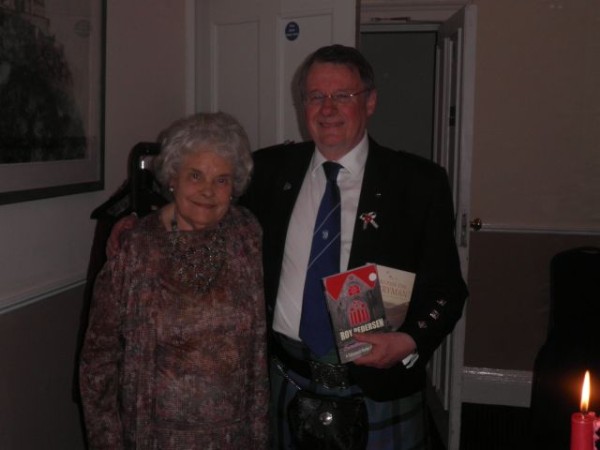
Honour Roy Pedersen, Convenor of Inverness branch
Trains, Ships Gaelic and Freedom
Born in Ardrossan where, on return from the war, his father worked at the harbour, Roy became steeped in transport from an early age, pushing his bike round the disused North Station and watching steam engines shunting and depositing their soot on his mother’s washing. Aged three he sailed to Northern Ireland on the Burns Laird turbine steamer Lairds Isle otherwise known as Smoky Joe. The next year (1948) the family moved to Aberdeen, where his father became superintendent of works at Aberdeen harbour, so he got to know all the ships that sailed to the Northern Isles and Leith. Aberdeen was a mecca for steam, but this time his mother complained so much about having to live amid industrial surroundings that they moved to the west end where he fell in love with the trams and the Queen’s Cross tram depot so keenly that he felt a sense of loss when the system closed soon after that of Edinburgh.
Aberdeen was linguistically bilingual, and to be upwardly mobile in those days, people had to learn Scottish Standard English. Passing his driving test enabled Roy to become a boy racer, which sadly led to him writing off his father’s cherished Lea Francis car. He graduated in geography and economic history from Aberdeen University. Moving to London, he joined the civil service which he did not take to, so he immersed himself in learning Gaelic, spending much time at the British Museum, creating and publishing the first Gaelic map of Scotland. This sold some 30,000 copies. Scots were, he found, well-regarded but Scotland seemed almost forgotten in terms of national policy, leading him to conclude that London rule was incompatible with Scotland’s future, and though now 70 years of age he regarded himself as 66 not counting the four years spent in London. Moving to Inverness and the Highlands and Islands Development Board (HIDB), he found a wonderful world which was helping transform its area into the dynamic region that it now is, moving Scotland’s centre of gravity northward.
Beginning as assistant secretary to the Highlands and Islands Development Consultative Council gave him an overview, then he moved to transport where he devised a ferry-charging report that launched the concept of Road Equivalent Tariff. A stint on social development working with Bob Storey allowed him to address the perception of the Highlands and Islands as an arts desert worthy only of subsidised touring companies performing in village halls - instead through the Fèis movement led by Barra priest Father Colin McInnes, HIDB began to promote the development of indigenous arts, and as himself the grandson of a Norwegian sea captain Roy set up a Norwegian learning group.
Co Chomuinn, self-help community cooperatives with their own field officers presaged the later move to community land buyouts. Then the crisis in the Gaelic language led to Roy joining Comunn na Gaidhlig as development director encouraging Gaelic-medium schools, tourism initiatives and the Gaelic college Sabhal Mor Ostaig. A key initiative, to reinforce Gaelic, in which he co-operated with his friend and colleague John Angus Mackay, was the creation of a Gaelic television service which would help pave the way for BBC Alba. As part of his minority language interests, he visited Galicia in 1989 and other minority language communities, which led to the writing and publication of One Europe : One Hundred Nations which explored the apparent paradox of a continent that was ever more united whilst many ‘stateless’ nations sought greater independence.
Returning to transport in HIE, the successor body to HIDB. Roy worked to create Highland Rail Developments which appointed Frank Roach to undertake rail development work, one of the first initiatives being launch a commuter train from Dingwall to Inverness in 1999. He identified the need for an air service that would enable Colonsay school kids to go home at weekends, wrote a report on ferry futures and supported a study by Prof Alf Baird advocating an Orkney container hub taking advantage of the shortest Atlantic crossing. Making the argument in Halifax Nova Scotia, he was glad that he had gone against local advice and booked a train journey to Saint John when 9/11 grounded all flights. Taking a package out of HIDB, Roy became a development consultant and was later elected to Highland Council where he chaired the Inverness Events and Festivals Working Group that, among other achievements, helped give Inverness the second biggest Hogmanay celebration in Scotland. He wrote Pentland Hero about Andrew Banks whose unsubsidised ferry the Pentalina on the Gills Bay-St Margaret's Hope short crossing now carries more cars and passengers than the heavily subsidised Northlink routes to Orkney. This true account proved to be a ripping yarn, so he moved into fiction, introducing the character of Brother Richard in Dalmannoch and Sweetheart Murder both of which he set in Galloway because he felt it to be a neglected part of Scotland : his third novel The Odinist will shift the scene to Skye. A study, undertaken jointly with Profess Alf Baird, showing the short sea crossing to be the least carbon-consuming means of reaching Orkney won prize for best paper at the 2012 Scottish Transport Applications & Research conference. A distillation of his ideas on improving Scotland’s ferry provision were published in his book Who Pays the Ferryman?. Roy has since been appointed to serve on the Scottish Government's expert ferries group where he continues to argue the case for short crossings. Now he is watching with interest the run-up to the independence referendum, and wonders if it will bring Scotland the greater freedom for which he has always yearned.